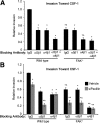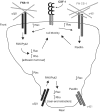Macrophage motility requires distinct α5β1/FAK and α4β1/paxillin signaling events
- PMID: 21084629
- PMCID: PMC3024900
- DOI: 10.1189/jlb.0710395
Macrophage motility requires distinct α5β1/FAK and α4β1/paxillin signaling events
Abstract
Macrophages function as key inflammatory mediators at sites of infection and tissue damage. Integrin and growth factor receptors facilitate recruitment of monocytes/macrophages to sites of inflammation in response to numerous extracellular stimuli. We have shown recently that FAK plays a role in regulating macrophage chemotaxis and invasion. As FAK is an established downstream mediator of integrin signaling, we sought to define the molecular circuitry involving FAK and the predominant β1 integrin heterodimers expressed in these cells-α4β1 and α5β1. We show that α4β1 and α5β1 integrins are required for efficient haptotactic and chemotactic invasion and that stimulation of these integrin receptors leads to the adoption of distinct morphologies associated with motility. FAK is required downstream of α5β1 for haptotaxis toward FN and chemotaxis toward M-CSF-1 and downstream of α4β1 for the adoption of a polarized phenotype. The scaffolding molecule paxillin functions independently of FAK to promote chemotaxis downstream of α4β1. These studies expand our understanding of β1 integrin signaling networks that regulate motility and invasion in macrophages and thus, provide important new insights into mechanisms by which macrophages perform their diverse functions.
Figures






References
-
- Kummer C., Ginsberg M. H. (2006) New approaches to blockade of α4-integrins, proven therapeutic targets in chronic inflammation. Biochem. Pharmacol. 72, 1460–1468 - PubMed
-
- Marshall D., Cameron J., Lightwood D., Lawson A. D. (2007) Blockade of colony stimulating factor-1 (CSF-I) leads to inhibition of DSS-induced colitis. Inflamm. Bowel Dis. 13, 219–224 - PubMed
-
- Mantovani A., Sica A. (2010) Macrophages, innate immunity and cancer: balance, tolerance, and diversity. Curr. Opin. Immunol. 22, 231–237 - PubMed
-
- Webb S. E., Pollard J. W., Jones G. E. (1996) Direct observation and quantification of macrophage chemoattraction to the growth factor CSF-1. J. Cell Sci. 109, 793–803 - PubMed
Publication types
MeSH terms
Substances
Grants and funding
LinkOut - more resources
Full Text Sources
Molecular Biology Databases
Research Materials
Miscellaneous

